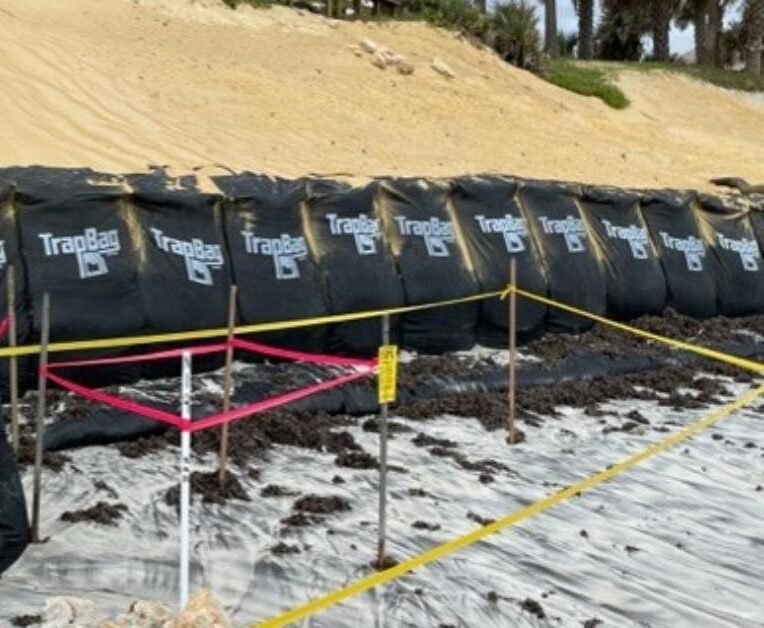Using TrapBag Cofferdam Bags for Temporary Cofferdams
Cofferdams are enclosures in the water that can be drained for underwater projects. They create the dry working environment many crews need to stay safe while working on underwater sites.
How to Use TrapBag Cofferdam Bags as Materials for Cofferdam Construction
TrapBag Cofferdam Bags are easier to install than other types of cofferdams and flood barriers and requires just a few simple steps:
-
Open the packaging: TrapBag Cofferdam Bags come folded up on a pallet. Open up each unit and get them ready for filling.
-
Fill the bags: Insert the forks on your forklift into the sleeves at the top of the bag. This helps hold the bag open for filling. Begin filling with gravel.
-
Lift the bags and set them in place: Once the bags are filled and ready to set in place, connect the eight straps on the TrapBag Cofferdam Bag to the 8-point spreader bar. Once connected, you can begin lifting and setting the TrapBag Cofferdam Bags into position.
Who We Serve
TrapBags help organizations of all types control water levels wherever they need to work. Some of the industries and organizations we support include:
Construction
Construction crews need temporary cofferdams to provide a dry place to work on bridges and roadways.
Learn More »Civil & coastal engineering
Civil or coastal engineering firms need a dry, stable environment to complete underwater infrastructure projects.
Learn More »Municipalities & governments
During public works projects such as bridge construction or pier installation, governments can use these in-water structures.
Learn More »Mining
Cofferdam construction methods are ideal for creating a dry environment for miners, no matter where the minerals or metals may be located.
Learn More »Environmental protection services
Environmental conservation groups can use cofferdams to make it easier to clean up riverbeds and more easily reintroduce native aquatic or amphibian species.
Learn More »Projects
How TrapBags Compare to:
These cofferdams are made with steel sheet piles that can hold back water and resist corrosion. These structures are ideal for sites in deeper water, such as construction projects in the middle of a large river or a harbor. They’re also ideal for projects that require long periods of work under the water, such as bridge construction.
However, for projects taking place in shallower water, sheet pile cofferdams can be less practical. TrapBag is ideal for these projects because it offers the same results with a far less expensive price tag.

Water-inflated cofferdams use water to create a sealed cofferdam that minimizes the amount of water in your work site. They allow crews to work more effectively in an area that wouldn’t be accessible normally due to the amount of water.
However, water barriers aren’t ideal materials for these structures. This is because they can puncture more easily, leaking water all over the site and causing the exact problem you were looking to prevent in the first place.

Sandbags have been used for everything from flood control to erosion protection for thousands of years. They can also be used to construct cofferdams on some projects, particularly in shallow waters such as along rivers and in shallow ponds or lakes.
However, sandbags are infamous for their high margin of error—your cofferdam could collapse and flood your work area if the structure is constructed poorly at any point. They are also more labor-intensive to fill and build.
By contrast, TrapBag can be filled in under an hour and be used to make a cofferdam for your in-water projects. TrapBag barriers are leak-resistant, making them an ideal alternative to sandbags.

In temporary cofferdam construction, engineers must balance the need for effective water exclusion with speed, adaptability, and cost efficiency. TrapBag’s cofferdam bags provide a purpose-built solution that simplifies this process by offering pre-engineered, rectangular units reinforced with rigid panels to maintain shape and facilitate watertight placement against adjacent bags. These modular units can be quickly filled, positioned, and lifted into place with standard equipment, creating a stable enclosure that supports dewatering and dry work zones in shallow and transitional water environments without the extensive labor, time, and heavy machinery traditionally associated with steel sheet piling or sandbag methods. The design’s inherent leak resistance and reusability make it a compelling option for infrastructure repair, bridge support, and waterfront construction projects where temporary cofferdam construction must meet rigorous performance and regulatory standards while minimizing environmental impact.”

Why Choose Reusable TrapBag Cofferdam Bags?
Unlike our standard TrapBags, the new TrapBag Cofferdam Bags are individual bags and not a chain of cells. These bags are rectangular shaped and do not have a sloped side. They have rigid coroplast panels on each side to help keep the rectangular shape and prevent the bags from bulging. This allows the bags to be flush against their adjacent bags when set in place.
TrapBag Cofferdam Bags are designed to be lifted in and out of place. Most water barriers require you to empty the fill material in place, which is not allowed for most cofferdam projects. That’s why we came up with a bag that could be lifted out of place and emptied in a different location. They are also reusable and stack together like building bricks. We offer 2-ft- and 4-ft–tall bags just like we do for TrapBags. A spreader bar is needed in order to lift the bags.
Our expert staff wants to help you get the most out of your next project. We’re here to help you 24/7 across multiple countries and continents.








